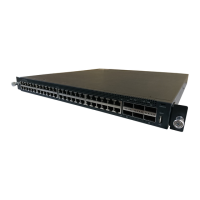User’s Guide FUJITSU PSWITCH
December/2018 73
3.1.2.8.9. Root Guard
Enabling root guard on a port ensures that the port does not become a root port or
a blocked port. When a switch is elected as the root bridge, all ports are designated
ports unless two or more ports of the root bridge are connected together. If the
switch receives superior STP BPDUs on a root-guard enabled port, the root guard
feature moves this port to a root-inconsistent STP state, which is effectively equal
to a listening state. No traffic is forwarded across this port. In this way, the root
guard feature enforces the position of the root bridge.
When the STP mode is MSTP, the port may be a designated port in one MSTI and an
alternate port in the CIST, etc. Root guard is a per-port (not a per-port per instance
command) configuration, so all the MSTP instances this port participates in should
not be in a root role.
3.1.2.8.10. BPDU Filtering
STP BPDU filtering applies to all operational edge ports. Edge Port in an
operational state is supposed to be connected to hosts that typically drop BPDUs. If
an operational edge port receives a BPDU, it immediately loses its operational
status. In that case, if BPDU filtering is enabled on this port then it drops the
BPDUs received on this port.
Ports that have the Edge Port feature enabled continue to transmit BPDUs. The
BPDU filtering feature prevents ports configured as edge ports from sending
BPDUs.
If BPDU filtering is configured globally on the switch, the feature is automatically
enabled on all operational ports where the Edge Port feature is enabled. These
ports are typically connected to hosts that drop BPDUs. However, if an operational
edge port receives a BPDU, the BPDU filtering feature disables the Edge Port
feature and allows the port to participate in the spanning-tree calculation.
Enabling BPDU filtering on a specific port prevents the port from sending BPDUs
and allows the port to drop any BPDUs it receives.
3.1.2.8.11. BPDU Flooding
STP BPDU flooding feature applies to the STP disabled switch. To enable BPDU
flooding on a port, STP should be disabled on the switch administratively. When
this feature is enabled on the switch, it floods all the ports with the BPDU flood
feature enabled on it. It only works on STP, RSTP or MSTP mode.

